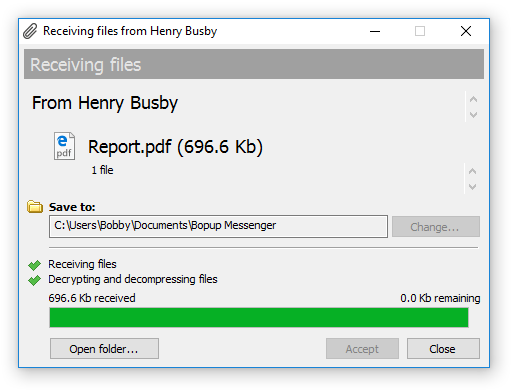Receiving files ("Classic Messenger" interface mode)
On a new incoming file transfer the messenger automatically opens and displays the Receiving files dialog box. It contains a sender name, list and size of delivered files. In cases when there is no opened conversation dialog with the sender, or it is closed (minimized) or another recipient is currently selected in the contacts then Bopup Messenger starts to blink it's icon in system tray area  and also an icon near the sender name in the Contact List.
and also an icon near the sender name in the Contact List.
According to receiving settings the messenger plays a sound file, restores (pops up) the main chat window, etc. on a file receipt. Those options are separate for personal (private) and group files transfers including assigned files delivered from the communication server.
The file transfer can be the following types:
- A Personal File Transfer that is initiated by other user
- A Group File Transfer that is initiated by user to a messaging group that you are a part of
- A File Distribution from the IM server that includes files and documents assigned to you by administrator
Click Change... button to change the folder where you want to save the received files. By defaut, Bopup Messenger stores all received transfers in your current "My Documents\Bopup Messenger" folder by creating a new sub-folder in the YYYY-mm-dd format where the YYYY-mm-dd is a date of transfer.
Click Accept to receive the data or Decline to abort the file transfer.
 |
| Receiving multiple files and folders |
Click Open folder... button when the transfer is completed to open the folder that contains received files and documents.
Please note that a file transfer can be sent with a set of advanced flags that may give you no options to decline the transfer, and/or automatically open/execute a received document after it's delivering. That file transfers can be a File Distribution transfers from the IM server and transfers that are sent by users that have Administrative or Power User account type on the communication server.
 |
Depending on settings confugured on a central IM server users are also able to exchange files without showing separate file transfer dialogs. In that case data is sent and received directly from a conversation window by choosing or dropping files into the dialog. |
 and also an icon near the sender name in the Contact List.
and also an icon near the sender name in the Contact List.

